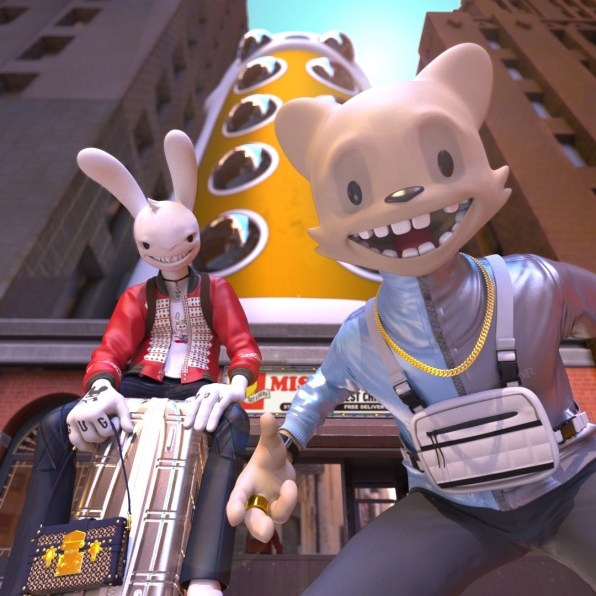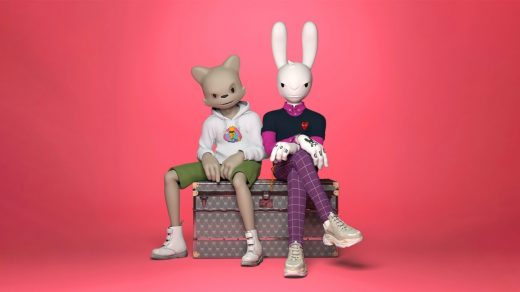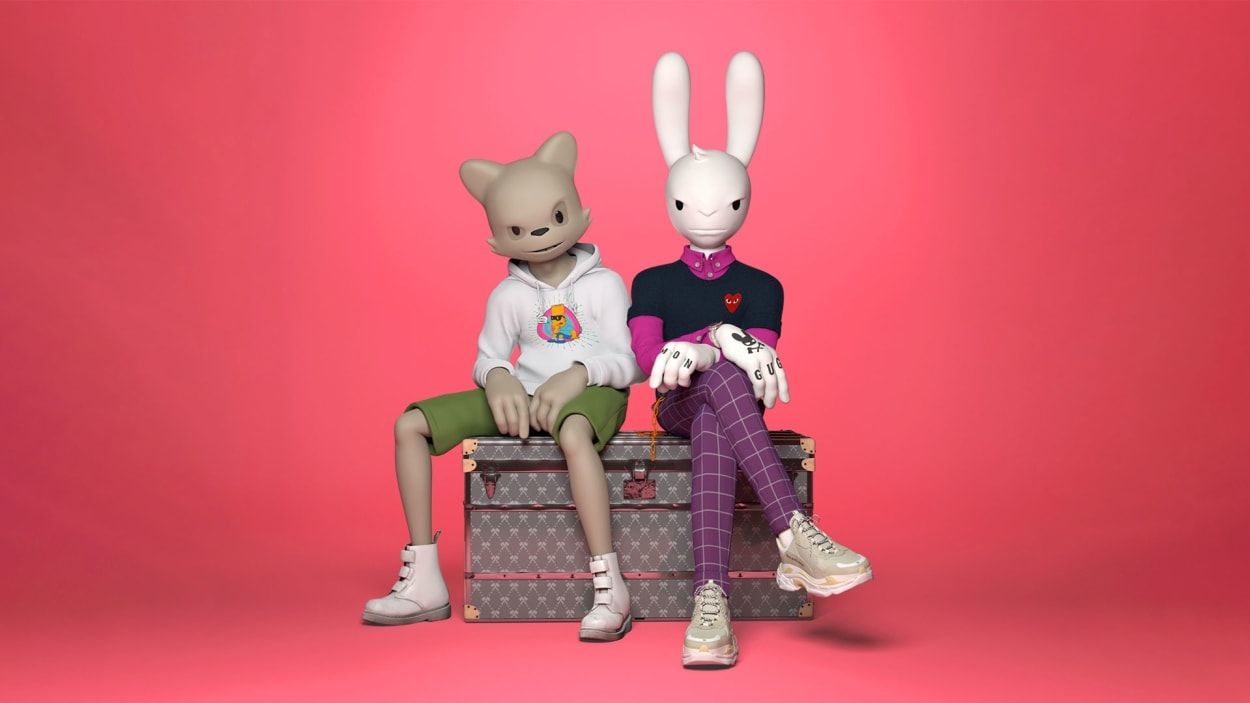Rise of the synthetic celebrity: Superplastic leads a new generation of influencers, and they’re unreal
In November 2021, when socialite and It-girl of the aughts Paris Hilton married venture capitalist Carter Reum at a swanky wedding in Bel Air, a red carpet gala’s worth of stars turned up: Nicole Richie, Kim Kardashian, Paula Abdul, Emma Roberts, Rachel Zoe, Kimora Lee Simmons, and Dayzee—a double-PhD in nuclear physics and aerospace engineering, who can rejig anything from a rocket launcher to a laser gun. It was no surprise that Dayzee was there. She’d been at Paris’s bridal shower, posing atop a pink mushroom-shaped stool, and weeks earlier they’d been snapped together in the desert wearing matching holographic sunglasses. At the wedding, Dayzee mingled with bridesmaids over hors d’oeuvres like every other guest, her jet-black eyes, purple hair, and blue skin gleaming.
Unlike the other guests, Dayzee is a so-called synthetic celebrity. She is a virtual character that exists in the digital ether, roaming from TikTok, to Instagram, to Twitter, to Discord, collecting millions of followers across channels, and pausing every now and then to DM with real-world celebrities and high-profile brands, sometimes leading to explosive “collabs”: short films show Dayzee, or her partners in crime—a mischievous cat-looking creature named Janky and the rabbit-esque Guggimon—modeling for Gucci, taking a road trip with Mercedes-Benz, or carrying out an epic heist at Christie’s art house.
Behind Dayzee and her friends is Superplastic, a hype machine of a company that manufactures these synthetic celebrities, along with their elaborate backstories (Janky and Guggimon are charming anarchists who might burn the world to the ground, if not for their love of streetwear and haute couture). “We’re an experimental character design studio, and we’re also a character universe,” says founder Paul Budnitz.
The Burlington, Vermont-based company’s origin story, much like its graffiti-inspired, punk-rock edgy aesthetic, is rooted in subverting expectations. And in some ways, it’s hard to nail down exactly what Superplastic is—but the best explanation might be a Disney- or Marvel-like empire of intellectual property. At its heart, it was born from Budnitz’s love of art and desire to build a character universe that he could keep expanding over time.
“Usually if you want to create animation, which is something I always wanted to do, what happens is you create an idea for an animated show, and then you sell it to a studio: Netflix, Warner Bros, or whoever—Fox, if you’re The Simpsons—and then they own it, you don’t own it anymore,” says Budnitz, who studied art at Yale University. “You get a cut, but they do whatever they want.”
Budnitz didn’t want that. What to do? Then the idea struck: “What if we could skip the studio, and make the characters super famous on social media?”
Superfamous
“Superfamous” they are: Superplastic’s synthetic celebrities, which now also include Staxx, a purple-skinned, tattooed “weapons and combat specialist,” have 18 million followers on social media, and that’s growing by a million each month. The company has since branched out into brand partnerships, in which its characters might be licensed out as metaverse runway models for Tommy Hilfiger’s Decentraland fashion show, or avatars in Fortnite, or music video stars for, say, the Gorillaz. They’ve also sold tens of millions of dollars in NFTs in the past few years—”before that whole crash,” Budnitz notes—and carved out a sizeable niche in merchandising, where they make thousand-dollar designer “toys” that look a little like Kaws, and a lot like Kidrobot, the first vinyl-figurine company founded by Budnitz in the early 2000s.
Take a walk through New York’s trendy Nolita neighborhood and you won’t miss Superplastic’s flagship storefront: In the gallery window is a larger-than-life sculpture of a plump Mickey Mouse-like figure, splayed out like Jesus Christ on the cross with a barbed halo and nails through its hands and feet, hung above six bars of solid gold. (Again, edgy is the move.)
These days, much of Superplastic’s revenue piles in from toy sales, borrowing from hypebeast culture with limited-edition drops that sell out in minutes. They’re also developing live events, where the characters can appear as holograms. “The characters are playing in all these different spaces, which then makes money and supports the company, as opposed to just making a cartoon and outsourcing to marketers, to have them make squirt guns,” says Budnitz. “And [in terms of I.P.], it all works out as a narrative.”

That narrative includes “Janky” and “Guggimon” becoming toy designers for collabs with J Balvin and Steve Aoki. But behind all of the creative decisions, of course, is a team of 50 human artist professionals at Superplastic. And now, they will become the scriptwriters behind that typical first step for most iconic characters that Budnitz resisted for so long: an animated TV show, in development at Amazon Studios, the company revealed Wednesday.
According to a news release, The Janky & Guggimon Show will follow the dynamic duo’s misadventures as they chase one chaotic get-rich-quick scheme after another. Each episode “features a cast of animated and human celebrity friends,” and if ordered to series, will debut on Prime Video in more than 240 countries and territories. Superplastic also signed a first-look deal with Amazon Studios for its other characters. Amazon’s fund declined to share the financial terms.
The deal comes alongside the company’s fourth Series A investment round, raising $20 million to bring its total venture capital funding to $58 million. The round was led by Amazon’s Alexa Fund, with other investors including Craft Ventures, Google Ventures, Galaxy Digital, Kering, Sony Japan, Scribble Ventures, Kakao, Animoca Brands, Day One Ventures, and Betaworks.
Hyperreal
Superplastic isn’t the only one in its space—in fact, it’s operating in an increasingly competitive landscape. In the age of artificial intelligence, new-wave synthetic celebrities have been supercharged into social media phenoms. Lil Miquela, a “19-year-old robot” powered by deepfakes has six million followers across Instagram and TikTok, and Lu of Magalu, a virtual influencer from Brazil, has over 30 million. They post photos of themselves in computer-generated scenes: eating pizza, petting puppies, wearing cute tank tops.
There’s also FNMeka, an AI-generated “robot rapper” who was signed by Capitol Records, then dropped after facing accusations of racial stereotyping. Even South Korea’s K-pop industry, known for producing singer-dancer idols with rabid fan bases, debuted its first AI girl group, Eternity, whose 11 members are all computer generated.
Paul Bernard, director of the Alexa Fund, has been observing all this. As he explains, the funds’ three focus fields are first, the creator economy (“shrinking the distance between fans and creators”); second, virtualization (“XR, the metaverse, VTubing“); and third, synthetics. But Superplastic, he says, achieves this “without the benefit of generative technologies like GPT-3 and Midjourney. . . . It realizes the power of humans to create compelling characters that can capture the zeitgeist and engage an at-scale audience.”
Still, Superplastic’s celebs might blur the line between the real and the digital, much like Web 2.0 and the new Web3 have begun to do today. You might roll your eyes and argue that Dayzee couldn’t really touch down in Los Angeles for Paris Hilton’s wedding, or Janky couldn’t really dream up toy designs—they don’t have brains, or physical bodies, for that matter. But when you Zoomed into the office meeting, were you really there? When you messaged with coworkers on Slack, did you really talk? When you read those celebs’ tweets, did they really write those—or did a PR agent spin out those words?
It’s a good question: Where do we live our lives? Last week, when Lebron James swished the basket that made him the highest-scoring NBA player of all time, Bernard muses, thousands in the arena were watching—through their phone cameras. Was it any different from seeing the clip on YouTube?
Existentialism aside, it’s hard not to note the similarities between Superplastic and the somewhat fizzled-out Bored Ape Yacht Club—which it partnered with for a set of toys last spring—in that both rely on pure intellectual property that cultivates hype online, which can then theoretically be transformed into myriad states of being. And as Web3 and NFTs, which were a key revenue driver for Superplastic, have sputtered, it may need to rethink its strategy—as well as its alignment with the “metaverse,” a concept that grows more mythical by the day.
For Budnitz, the human element is what keeps his characters alive. “They’re just really funny,” he says, “and lovable. My thing was to be edgy and lovable at the same time, which is hard to pull off. Guggimon’s gone to rehab once already, and Janky tends to get run over by things. People identify with them. When they got picked as models for Gucci, it was hilarious—because Janky can go straight from that to mouthfuls of chicken nuggets.”
While Budnitz can’t share much detail on the TV show, you can bet that it’ll slap. “We’re very picky—if it’s not cool and it’s not fun, we don’t do it,” he says. “We like Mercedes because they let us redesign a 1970s bobblehead dog they had. I had one of them on the dashboard of my car. We asked, ‘Can we redo this?’ There was a long German pause . . . and then, they said, ‘sure.’ We’re just a bunch of artist weirdos.”
(21)



